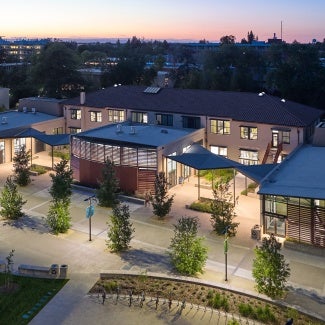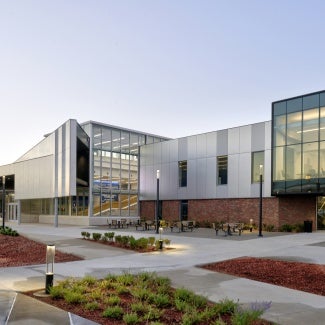University of Illinois at Chicago, Academic and Residential Complex (UIC ARC)
The award-winning education facility design of the Academic and Residential Complex creates UIC’s first living-learning community while bridging the gap between its architecturally rich past and innovative future.

Project highlights: University of Illinois at Chicago, Academic and Residential Complex (UIC ARC)
- Architecture firm: Solomon Cordwell Buenz (SCB)
- Owner: American Campus Communities (ACC)
- Location: Chicago
- Category: Merit
- Project site: Previously developed
- Building program type(s): Mixed-use
Soaring enrollment at the University of Illinois at Chicago prompted this project, the university’s first living-learning community. Designed as a nod to the work of Walter Netsch, the campus’ original architect, the complex addresses the university’s critical needs while also serving as a vital bridge between its architecturally rich past and its innovative future.
The complex arose from a 10-year master plan aimed at reshaping the university’s physical development. Though it was originally a commuter school, the university has experienced increased enrollment, prompting the need for new academic and residential facilities. A $95 million public-private partnership allowed the team and university leadership to explore merging two campus building typologies into one development.
At 200,875 square feet, the new building is divided into a 554-bed residence hall for undergraduates and a two-story academic building. The academic portion contains a series of formal and informal learning spaces, including two flexible classrooms, two active learning classrooms, and two sizable turn-to-team classrooms. Break-out spaces are interspersed throughout the building to encourage collaboration between students and encourage interactions with faculty.
The campus masterplan was also developed by Netsch, who developed a concentric organization of the campus, like a stone dropped in a pond, where low-rise academic buildings stand at the center and taller student-support buildings ripple out into Chicago. The complex’s massing adheres to this idea, with its academic side oriented to the academic core and its 10-story residential tower toward the greater city.
Though it’s inspired by the university’s architectural legacy, the design for the complex departs from its larger brutalist vocabulary. Its siting offers optimal solar orientation that mitigates heat gain, while extensive daylight studies shaped the design of the complex’s exterior fins that draw in natural light while blocking glare. Expanses of glass on the ground floor and throughout the academic spaces are a stark contrast to other buildings nearby. On a lush, landscaped public plaza, passersby are treated to glimpses of student activity in the complex.
Its facade and interior designs reflect the geometric movement displayed in Netsch’s famous “field theory” and distinctive architecture. To maintain consistency with existing campus buildings, the team employed precast concrete but with a lighter and more transparent approach. The team worked closely with a subcontractor to develop three adaptable pre-cast forms that could be manipulated to produce the 70 panel types that comprise the facade, the modularity of which allowed for a streamlined construction sequencing.
In its construction, the complex demonstrates how integrated planning can be joined with a P3 delivery method to address the trio of academic, institutional, and developer goals. With a lack of state funding for capital projects, it is a model for innovation despite a stymied state system.
Framework for Design Excellence measures
Was there a design charrette? Yes
Level of community engagement:
Involve: Stakeholders were involved throughout most of the process.
Site area that supported vegetation (landscape or green roof) pre-development: 3%
Site area that supports vegetation post-development: 46%
Site area covered by native plants supporting native or migratory species and pollinators: 33%
Strategies used to promote Design for Ecosystems: Dark skies, Habitat conservation, flora/fauna, Abatement of specific regional environmental concerns
Is potable water used for irrigation? No
Is potable water used for cooling? No
Is grey/blackwater reused on-site? No
Is rainwater collected on-site? Yes
Stormwater managed on-site: 85%
2030 Commitment baseline EUI: 91 kBtu/sf/yr
Predicted net EUI including on-site renewables: 51 kBtu/sf/yr
Reduction from the benchmark: 44%
Is the project all-electric? No
Level of air filters installed: MERV 12-14
Was a “chemicals of concern” list used to inform material selection? No
Do greater than 90% of occupied spaces have a direct view to the outdoors? Yes
Were embodied carbon emissions estimated for this project? No
Estimated service life: 80 years
Floor area, if any, representing adapting existing buildings: Not applicable
Ability to survive without utility power: Not habitable without power
Risk assessment and resilience services provided: Not applicable
Has a post-occupancy evaluation been conducted? Yes
Building performance transparency steps taken:
Present the design, outcomes, and/or lessons learned to the office.
Present the design, outcomes, and/or lessons learned to the profession.
Present the design, outcomes, and/or lessons learned to the public.
Project team & Jury
Year of substantial project completion: 2019
Gross conditioned floor area: 200,875 sq. ft.
Architect: Solomon Cordwell Buenz (SCB)
Engineer - Civil: TERRA Engineering
Engineer - MEP: Elara Energy Services
Engineer - Structural: Thornton Tomasetti
General Contractor: Pepper Construction
Landscape Architect: site design group
Interiors, Academic: SCB Interiors,
Residential: Sixthriver Architects
Acoustical, AV: Threshold Acoustics, LLC
Façade access: Lerch Bates Commissioning: dbHMS
Lori Cappucio, AIA (Chair), SmithGroup, Washington, DC
Omar Bailey, AIA, Shepley Finch, Phoenix
Vince Gonzales, AIA, Seattle Public Schools, Seattle
Kandis Larsen, AIA, Integrus + YGH, Spokane, Wash.
Sindu Meier, AIA, William Rawn Associates, Milton, Mass.
The Education Facility Design Award recognizes state-of-the-art education environments being developed in today's learning spaces.
Thirteen projects showcase the best in today's learning spaces.













